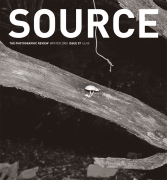Melancholy Objects; Signs of Life
by Annabelle Dalby
Issue 57 Winter 2008
View Contents ▸
View photographs from Rookery, Cobweb ▸
Fallen trees, hanging branches, broken twigs and gnawed leaves are documented in the predominantly black set of Tim Edgar’s images. Alike, in the white images are what seem to be spiders’ legs; flies’ torsos, wings and other disembodied insect parts, not all decipherable. What lies amongst both sets of photographs are not just signs of life, of some sort of activity, but remnants, leftovers.
Tim Edgar’s Rookery (2003) and Cobweb (2008) series are made up of 14 and 20 photographs respectively, each documenting, as their titles describe, nesting sites in unsettling environments. The images are like those of a crime scene, they show us the more dangerous and uneasy side of nature’s activity. Focusing on conflict and ritual, neither the rooks nor the prey, the spider or the fly, are totally present in the photographs.
At first glance the Rookery images have elements of both chaos and care in their aesthetic approach. Seemingly snapshot, although taken on a large format camera, Edgar focuses his study on the traces of the rooks’ activity. The absence of the main protagonists adds to the graphic crime scenelike quality of the pictures, reminiscent of Weegee’s Naked City (1945). Weegee’s brightly lit, dramatic close-ups define myth and reality in the city in the same way as Edgar’s images do of the natural world. The extreme blackness of Rookery, intentionally shot with flash during the day, adds to the precarious atmosphere of the forest below the nests.
The black space in the photographs can also be linked to the blackness of the birds. As Roger Deakin says "any rookery confers a special atmosphere on a place, but rooks have always been controversial. Even today, there are those who persist in the belief that rooks are an enemy" (The Rookery, 2008). The blackness of rooks, crows and ravens alike have always perhaps made them suspect to people. This threat hovers silently in the darkness of Edgar’s images.
Although we can associate rooks initially with peril so too can we compare their rituals with those of the protective parent. "Rooks build their untidy-looking nests of twigs in a series of strata on top of the previous year’s structure"; apparently young rooks return and try to nest in the parent rookery. So Edgar’s ritualistic returning to photograph his subject matter again and again suggests both paternal fascination and some sense of fear about what he might encounter. As any parent would, he hovers, always close by, attempting not to interfere, casting his neutral eye upon the rooks and spiders’ activities.
This return is inherent both in the nature of photography – the need to document, record and observe – and in Edgar’s approach. He drifts through the landscape, inspired and repelled by the surrounding scenes of majesty and dilapidation. He is "not attracted to the official realities" of his subject "but to its dark seamy corners, it’s neglected populations" (On Photography, 2002). Like Brassai in the city, hovering, strolling and observing, Edgar too returns to the nesting sites in order to capture his evidence and experience it.
The black space of Rookery plays a similar critical role to the white space of Cobweb; the duality here is rooted in emptiness. They balance and oppose each other at the same time. This duality can be associated with a Japanese aesthetic; photographers such as Daido Moriyama and Masao Yamamoto both use extreme black and white within their work, formally and metaphorically, to speak of larger cultural, social and emotional issues. This binary force is found in the numerous opposites within both series; it defines the work and forms the basis of the themes that Edgar explores.
In Rookery Edgar points to the emptiness of the forest, the uninhabited nest and the terror of the missing corpse. In Cobweb we are faced more directly with the actual corpse. As the darkness of Rookery masks the environment so too does the white space of Cobweb overwhelm us, however beautifully, with death itself. Capturing the dead has long been a fascination for photographers and in Cobweb Edgar employs a macro lens to gain a microscopic view, abstracting these graveyard findings in a meticulous forensic fashion with curiosity and detachment.
An abstract quality comes into play in Cobweb, like that of certain modernist paintings; a playful expressionist style similar to Motherwell, Klee or Miro can be seen within its commotion. The abstraction of legs, wings and torsos hover in the magic of the whiteness. Thus, far from distorting its subject, the image delivers us towards an intimacy. It helps us grasp the object more ideally, but at the same time it holds us at a distance from any view of its totality.
Spiders are depicted in popular culture, mythology and symbolism as either heroine or objects of horror. Although the menace of both rook and spider pervades in Edgar’s images, there is a gentle positive space as well. "Certain American Indian tribes believe that the spider is the Universal Grandmother, who sits in the corner weaving, unnoticed until needed... it is considered a good fortune to have a Black Widow spider at the entranceway of one’s home – as both welcome and caution’" (To Create Sympathy in the Home, J Durham). The home invites and requires vigilance. By photographing these melancholy objects, the remains, Edgar shows us nature’s details and the ebb and flow of the world we live in.
Other articles mentioning Tim Edgar:
Other articles mentioning Daido Moriyama:






